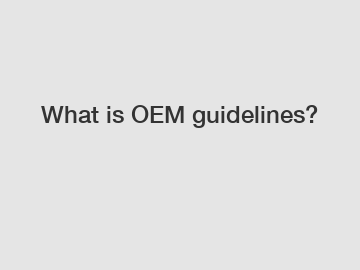What is OEM guidelines?
What is OEM guidelines?
OEM guidelines, also known as Original Equipment Manufacturer guidelines, refer to a set of instructions and specifications provided by a manufacturer to its subcontractors or partners. These guidelines outline the requirements, standards, and procedures that need to be followed in order to produce products that meet the manufacturer's specifications and maintain the quality and consistency desired.
The origin of OEM guidelines can be traced back to the manufacturing industry, where companies began to outsource certain parts or components of their products to specialized subcontractors. In order to ensure that these subcontractors produced the parts to the desired specifications and quality standards, the manufacturers created guidelines that provided clear instructions and requirements.

The process of developing OEM guidelines typically involves collaboration between the manufacturer and the subcontractor. The manufacturer provides detailed information about the product, including its design, materials, dimensions, and any specific performance or functionality requirements. The subcontractor then uses this information to develop a production plan that aligns with the manufacturer's goals and specifications.
Once the OEM guidelines are established, the subcontractor follows them closely throughout the production process. This ensures that the finished products meet the manufacturer's expectations in terms of quality, performance, and consistency. The guidelines may cover a wide range of aspects, including design specifications, testing procedures, quality control measures, and packaging requirements.
The significance of OEM guidelines lies in their ability to maintain consistency and quality across different production locations or subcontractors. By providing clear instructions and specifications, manufacturers can reduce the risk of variations or defects in the final product. This is particularly important for industries that rely on uniformity, such as automotive, electronics, and pharmaceuticals.
Moreover, OEM guidelines also serve as a tool for effective communication between the manufacturer and the subcontractor. They ensure that both parties have a mutual understanding of the desired product specifications and expectations. This helps to minimize misunderstandings and streamline the production process, resulting in improved efficiency and reduced costs.
In terms of impact, following OEM guidelines can lead to improved customer satisfaction. When manufacturers consistently deliver high-quality and reliable products, it builds trust and loyalty among customers. Additionally, adhering to guidelines can also enhance brand reputation and differentiate a manufacturer from competitors.
In conclusion, OEM guidelines refer to a set of instructions and specifications provided by a manufacturer to its subcontractors or partners. These guidelines are essential for maintaining consistency, quality, and communication throughout the production process. By adhering to these guidelines, manufacturers can ensure that their products meet the desired specifications, resulting in improved customer satisfaction and a strong brand reputation.
If you want to learn more, please visit our website wholesale auto alternators, starter motor manufacturer, 12v oem starter.


